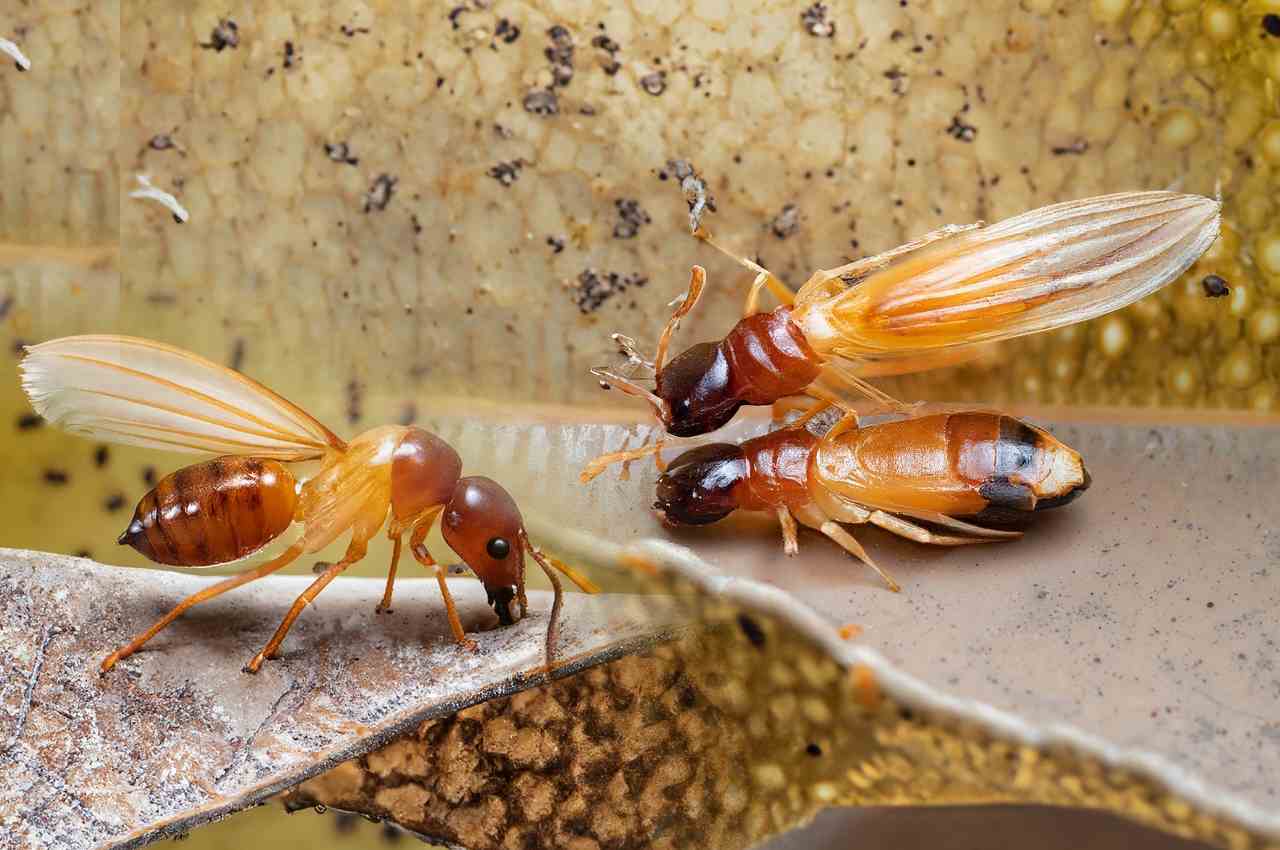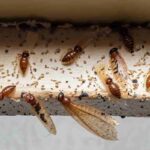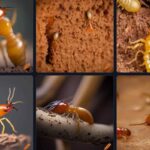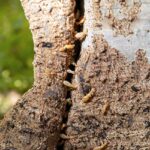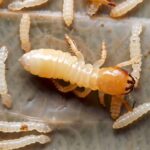Interested in knowing Which termites have wings? This page simplifies the several termite species that may fly and their effects. Termites are notorious for the severe damage they can do to timber buildings like houses. These tiny insects, which eat cellulose, may seriously damage structures if not managed. Examining the termites’ wings is one method of identifying them. When attempting to identify an infestation, it might be confusing since not all termite species have wings. Effective treatment and control of termite infestations depend on being able to differentiate between species with wings and those without.
This article will look at the several kinds of termites that may grow wings and what these wings are used for. When faced with termite problems in their house, homeowners may make educated choices if they are aware of the distinctions between winged and wingless termites. It is possible to conduct targeted control measures before significant damage occurs by correctly recognizing the termites that are present. Understanding the species that have wings is essential to effectively repelling these harmful insects.
Different types of termites with wings
| Termite Caste | Description | Significance |
|---|---|---|
| Swarmers | Reproductive termites that leave the colony and go out to find mates and establish new colonies. | Important for the colony to reproduce and expand. |
| Soldiers | Termites that guard the colony from parasites and predators. | Important for the colony's survival. |
| Workers | Caste that is most abundant in a termite colony. Execute all actions required to maintain the colony operational. | Important for the colony's survival. |
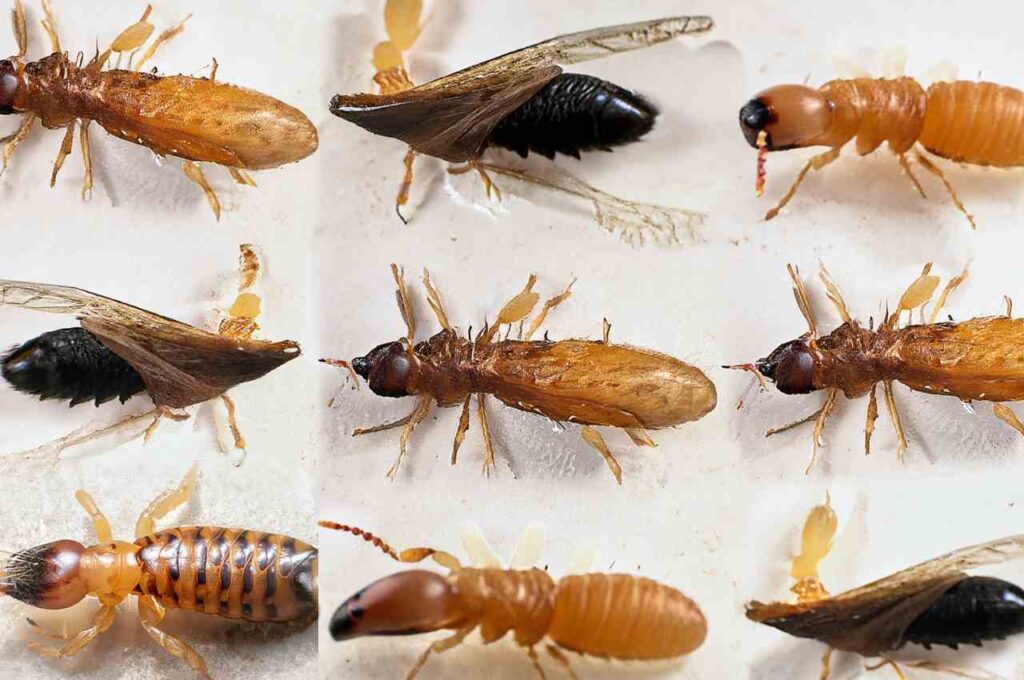
Importance of Understanding Which Termites Have Wings
Termites are colonial-dwelling social insects. They are insects that consume wood and may seriously harm buildings. There are three castes of termites: reproductives, soldiers, and workers. The only termites with wings are reproductives.
Knowing which termites have wings is crucial since doing so might help you spot a termite infestation. Swarmers are termites with wings. To reproduce and establish new colonies, they leave the colony. Swarmers are a clue that there could be a termite infestation if you notice them in your house.
Differentiating Termites with Wings
Swarmers, or winged termites, are essential to the colony’s growth. These winged reproductives emerge to take flight and establish new colonies somewhere else. Swarmers are often the first audible indication of a termite infestation. But not every species of termite produces flying swarmers. Termites are split into castes according on how they serve. The bulk of the colony is made up of the working caste. Worker termites lack wings and have squishy bodies.
Their duties include finding food, constructing the nest, and caring for the young termites. For colony defense, members of the soldier caste have larger heads and powerful mandibles. Soldier termites lack wings, just like workers. Wings are only developed by the reproductive caste of certain species of termite. Finding flying swarmers helps identify the species of termites that are infesting a building. Since not all termite species can be managed in the same manner, this influences treatment strategy.
| Aspect | Details |
|---|---|
| Swarmers/Winged Termites | • Vital for colony growth. • Emerge for flight to establish new colonies elsewhere. • Often the first sign of infestation. |
| Termite Species Variation | • Not all termite species have flying swarmers. • Species vary in their reproductive and winged caste development. |
| Termite Castes | • Majority of the colony consists of worker termites. • Workers lack wings and have soft bodies. • Perform essential tasks such as foraging, nest building, and caring for the young. |
| Soldier Termites | • Soldiers have larger heads and strong mandibles for colony defense. • Similar to workers, they lack wings. |
| Reproductive Caste Development | • Only reproductive caste of certain species develop wings. • These flying swarmers are key for mating and colony initiation. |
| Identification Importance | • Identifying flying swarmers aids in determining the termite species infesting a building. • Influences treatment approach. |
Significance of winged termites (swarmers)
The reproductive termites in a colony are called winged termites, often referred to as swarmers or alates. To reproduce and establish new colonies, they leave the colony. Swarmers are drawn to light, therefore windows and lights are often where people may notice them flying about.
Due of their susceptibility to parasites and predators, termites should avoid swarming. To reproduce and grow, the colony must take this step, however.
Not all termite species have wings
Some kinds of termites lack wings. Termites without wings are those that inhabit wet habitats, such as dampwood termites. This is so they can locate food and mates without having to fly.
Roles of termite soldiers and workers
Soldiers and workers are the other two classes of termites. The colony is protected by soldiers against parasites and predators. They have huge heads and jaws that are strong. A termite colony’s worker caste is the largest. They carry out all of the duties required to maintain the colony, including food gathering, nest construction, and child care.
Characteristics of Winged Termites
| Aspect | Description |
|---|---|
| Physical Features | • Size: About 1/4 to 3/8 inch long • Wings: Four wings of equal size, clear or translucent with slight iridescence • Body: Slender • Antennae: Short and straight |
| Behavioral Patterns during Swarming Season | • Swarming Time: Spring and summer months • Attracted to: Light sources such as windows and lights • Mating: Find a mate, shed wings, start new colony |
| Sign of Infestation (Shed Wings) | • Indication: Piles of shed wings around the home • Shedding: Termites shed wings after swarming • Locations: Window sills, around doors, crawl spaces |
Variations in Termite Wings
Size and shape
Depending on the species, termite wings may vary in size and form. Termite wings are typically the same length and size. But some animals have bigger or smaller wings than others. The wings’ appearance might also change. Some species’ wings are more triangular, whilst those of other species are more oval.
Color
Depending on the species, termite wings may also have a variety of colors. Termite wings are typically transparent or clear. Some species do, however, exhibit wings with brown or yellow tints. Depending on the termite’s age, the wings’ color may also alter.
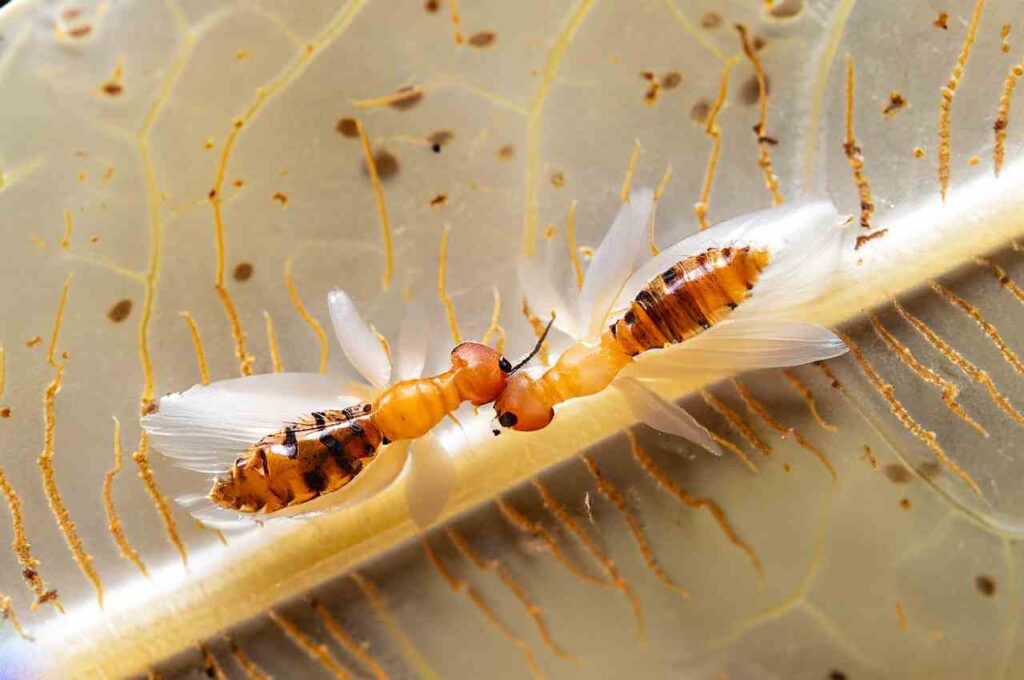
Venation patterns
Termite wings’ venation patterns may be used to determine the species. The lines that go through the wings are known as venation patterns. Each type of termite has its own design.
Differences between subterranean, drywood, and dampwood termites
Subterranean, drywood, and dampwood termites all have somewhat different wing appearances. The wings of subterranean termites are transparent or clear. Drywood termites have transparent or translucent wings that sometimes have a tinge of brown. The color of dampwood termites’ wings is often deeper, and they may look more iridescent.
The several termite wing variants are listed in the following table:
| Termite Species | Size | Shape | Color | Venation Patterns |
|---|---|---|---|---|
| Subterranean termites | About 1/4 to 3/8 inch long | Triangular | Clear or translucent | Unique to each species |
| Drywood termites | About 1/4 to 3/8 inch long | Oval | Clear or translucent with a slight brown tint | Unique to each species |
| Dampwood termites | About 1/4 to 3/8 inch long | Oval | Darker in color, often with an iridescent appearance | Unique to each species |
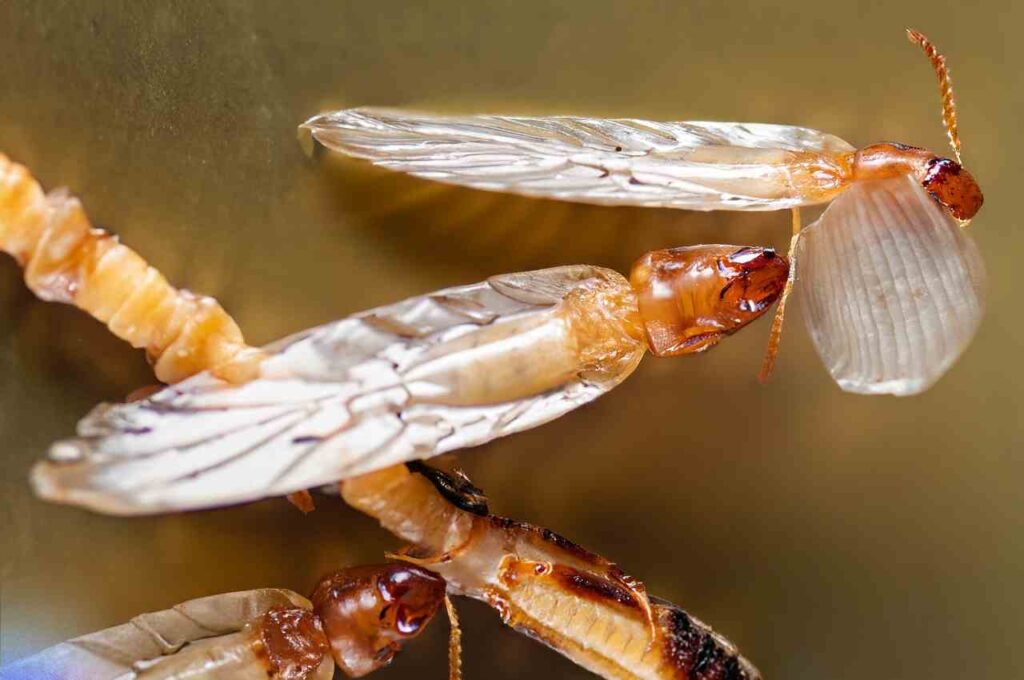
Importance of Recognizing Winged Ants vs Termites
| Key Difference | Winged Ants | Winged Termites |
|---|---|---|
| Body Shape | • Narrow waist • Pinched waist | • Wider waist • Straight waist |
| Wing Size and Shape | • Front wings larger than back wings | • Wings are the same size |
| Wing Color | • Often tinted brown or yellow | • Clear or translucent |
| Antennae | • Elbowed antennae | • Straight antennae |
| Behavior | • Attracted to food sources | • Attracted to moisture |
| Nest Location | • Build nests above ground | • Build nests underground or in wood |
| Defensive Mechanism | • Can sting | • Do not possess a stinging capability |
| Types of Damage | • Contaminate food • Nuisance | • Damage wood structures and materials |
| Importance of Recognition | • Contamination of food • Nuisance issues | • Potential for significant structural damage |
| Identification | • Professional identification recommended if found indoors | • Pest control professional identification advised |
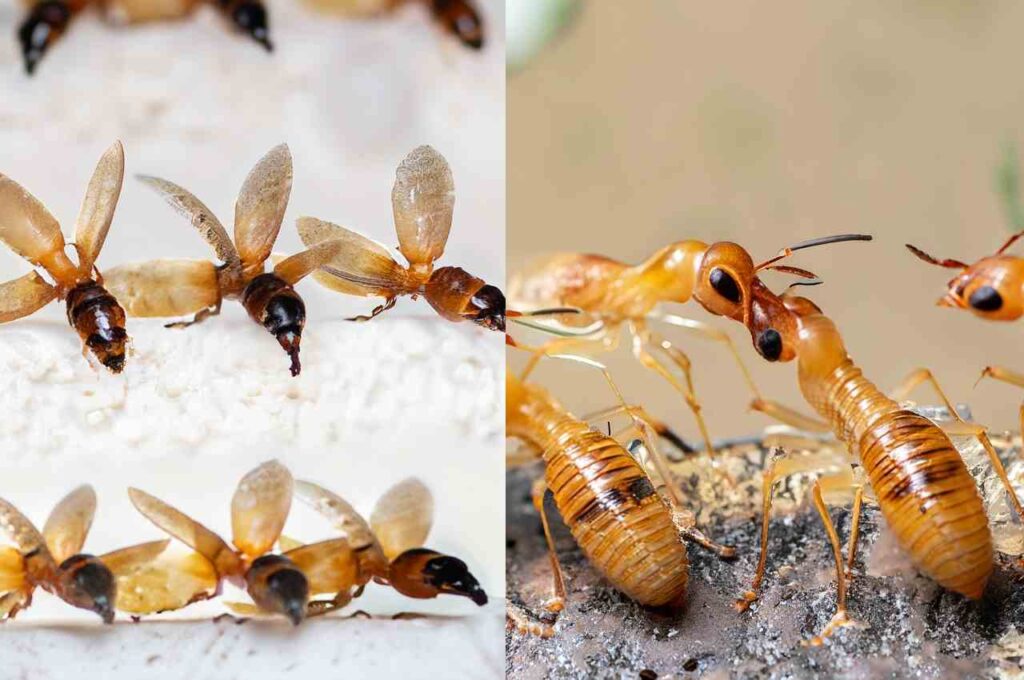
Identifying Winged Termites at Home
| Tips to Identify Winged Termites at Home | Description |
|---|---|
| Look for Winged Insects | • Size: About 1/4 to 3/8 inch long • Four wings of equal size and length • Flight pattern: Around windows and lights |
| Look for Piles of Shed Wings | • Shedding after swarming • Locations: Window sills, around doors, crawl spaces |
| Look for Signs of Wood Damage | • Damage caused by feeding on wood • Signs: Soft, spongy wood, presence of sawdust |
| Immediate Action | • Contact pest control professional immediately if signs are observed • Avoid disturbing termites to prevent infestation spread |
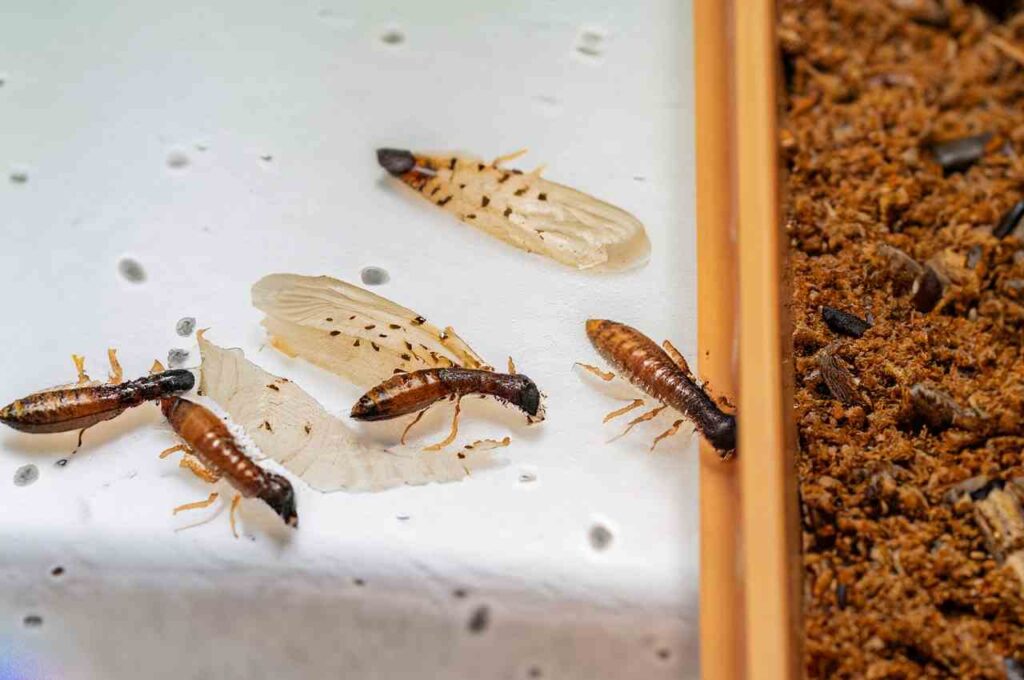
Taking Action Against Termite Infestation
| Action Against Termite Infestations | Description |
|---|---|
| Step 1: Professional Inspection | • Have a pest control professional inspect your home • Identify if termite infestation is present • Receive treatment recommendations |
| Step 2: Treat the Infestation | • Pest control methods: inspections, localized treatments, bait stations • Target and eliminate termite colonies |
| Step 3: Reduce Future Infestations | • Maintain a dry environment to deter termites • Fix leaks, cracks in foundation or exterior • Seal cracks and holes |
| • Keep trees and shrubs away from the home to prevent termite access • Regular professional inspections and preventive measures |

Conclusion
It’s essential to comprehend the importance of termite wings in order to spot prospective infestations. Winged termites, also known as swarmers, are a crucial symptom of a termite infestation because they indicate the appearance of reproductive termites looking to build new colonies. If you suspect an infestation, acting quickly is essential since termites may do serious damage to properties if ignored. Promptly seeking expert help assures accurate diagnosis and efficient therapy. Maintaining a dry climate, caulking foundation cracks, keeping trees away from your house, and scheduling routine professional termite inspections all contribute to preserving your property and reducing the danger of infestation.
Frequently Asked Questions
Which termites have wings?

Only reproductive caste termites, sometimes called alates or swarmers, have wings. Termites called alates leave the colony to mate and establish new colonies. They have four identically sized and sized wings. The wings are transparent or clear and they might have a faint iridescence. Termites have small, straight antennae, and their bodies are slim.
Soldiers and workers are the other two classes of termites. The colony is protected by soldiers against parasites and predators. They have huge heads and jaws that are strong. A termite colony’s worker caste is the largest. They carry out all of the duties required to maintain the colony, including food gathering, nest construction, and child care.
Additional information on termites and their wings is provided below:
- Termite swarmers have four identically sized and sized wings.
- The wings are transparent or clear and they might have a faint iridescence.
- Termites have small, straight antennae, and their bodies are slim.
Swarms of termites are often seen flying around windows and lights because they are drawn to light.
Do all termites have wings?
None of the termites have wings. Only termites’ reproductive caste, alates or swarmers, has wings. These flying termites leave the colony to mate and start new colonies. Soldiers guard the colony with their larger heads and jaws, while workers forage, construct nests, and care for the young. Termites without wings are workers or soldiers, whereas those with wings are swarmers or flying ants, which are related.
What are winged termites called?
Alates or swarmers are winged termites. Alates, termites’ reproductive caste, leave the colony to mate and start new colonies. They have four equal-sized, transparent wings that may be iridescent. Alates have short, straight antennas and slim bodies. Swarming is essential to termite survival, yet it entails hazards. If winged termites are found in your house, call a pest control specialist immediately for diagnosis and treatment. Spongy wood and sawdust are evidence of termite damage and their attraction to moisture-prone regions.
How can I identify termites with wings?
Termites with wings have four wings of similar size and length, transparent or translucent with a potential iridescent look, a thin body, and short, straight antennae. Spongy wood or sawdust indicate their affinity to moisture-prone places and ability to destroy wood.
Are termite wings the same size?
Actually, termite wings are the same size. Termite swarmers have four equal-sized, transparent, maybe iridescent wings. These wings let termites fly to find mates and start new colonies. Termite swarmers drop their wings after mating, and these wings may be discovered near windows, doors, and crawl spaces, indicating an infestation.
Do winged termites pose a threat to homes?
Yes, winged termites threaten houses. These flying termites, called alates, leave the colony to locate mates and start new colonies. They may inflict considerable harm if they start new colonies near dwellings owing to their wood-eating propensity. Termites eat wood cellulose and ruin walls, insulation, and furniture. Winged termites must be reported to a pest control specialist immediately for identification and treatment. Keeping the house dry, closing foundation cracks, removing trees, and arranging frequent expert inspections will reduce termite infestations.
When do termites develop wings?
Termites mature with wings after three to four years. Alates, or swarmers, emerge from colonies to mate and start new ones and grow wings. The queen termite produces hormones that cause wing expansion when she’s ready to swarm. Their translucent chitin wings, attached to their bodies by small muscles, let termites fly and find food and mates. After mating, swarmers lose their wings near windows, doors, and crawl spaces, indicating a termite infestation.
Are termite swarmers the only ones with wings?
Termite swarmers are not the only winged. Swarmers are the major flying termite reproductive kings and queens that leave the colony to mate and form new colonies. The main difference is that only termite swarmers fly and disperse to create new colonies. Reproductive termite queens acquire wings but lose them after establishing a home. Kings have wings but stay with the queen to raise the colony’s young. Termite workers do colony labor and warriors fight against attacks without wings.
Do winged termites fly?
Yes, winged termites, also referred to as alates, are capable of flying. These reproductive termites mate and start new colonies. Winged termites use their wings to find food and mates. The wings also help them stay aloft when swarming. Termite swarmers drop their wings along window sills, doors, and crawl spaces after mating, indicating an infestation.
Can flying termites colonize?
Yes, flying termites (alates) may start new colonies. Alates, the reproductive caste of termites, mate and start new colonies. Alates lose their wings and find new colonies after mating. These sites will see the queen termite lay eggs and grow the colony. These new colonies need food and water to flourish. The wood-eating termites construct nests in wood but may also destroy walls, insulation, and furniture.
What is the function of termite wings?
The main function of termite wings is flying. Winged termites, or alates, reproduce termite colonies. They mate and create colonies. The wings let termites fly to find food and mates. Wings let termites stay airborne when swarming. Termite swarmers lose their wings after mating, leaving them near windows, doors, and crawl spaces.
Are termite wings clear or colored?
The wings of termites are transparent or translucent, although their color varies by species. Drywood termites have brown or yellow wings. Subterranean termites have transparent or translucent wings, drywood termites have brown or yellow wings, Formosan termites have brown or black wings, and dampwood termites have clear or translucent wings. Recognizing termite wing color and traits aids identification and pest control.
How can I differentiate winged termites from other insects?
These traits distinguish flying termites from other insects: Unlike ants, termites have transparent or translucent wings that are consistent in size and length. Termites have thin bodies and straight antennae, unlike other insects. Termite swarmers fly around windows and lights, unlike moths and butterflies. Termite swarmers are also found in wet environments like crawl spaces and water sources, unlike other flying insects.
Does light attract flying termites?
Yes, light attracts winged termites. This attraction guides their swarming. Swarming termites release a light-loving pheromone that attracts other termites. Thus, winged termites swarm around windows and lights because they use light for navigation rather than being drawn to it.
What should I do if I find winged termites in my home?
If you find flying termites in your house, act quickly. A pest control specialist should evaluate and treat the house immediately because to the potential for major damage. Termites are difficult to eradicate, therefore self-extermination might aggravate the issue. Sealing foundation or exterior cracks and holes, keeping your property dry, and keeping trees and bushes away from your home are additional suggested termite prevention strategies.
- How do termite mounds help regulate temperature? - 7 January 2024
- 10 Effective Termite Control Methods That Actually Work - 4 January 2024
- How Long Does It Take for a Termite Mound to Form? - 21 December 2023
